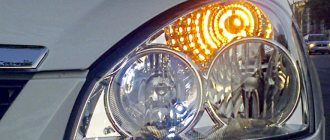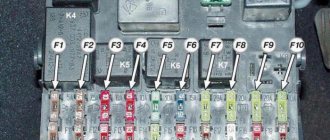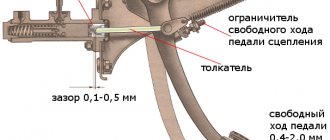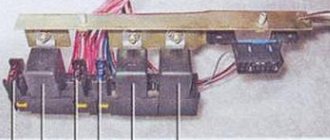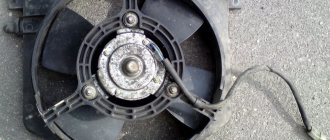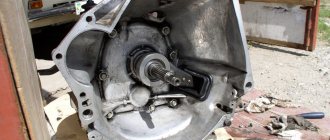VAZ turn signal relay - do-it-yourself diagnostics and replacement
Turn signals are perhaps a very important part of any vehicle. Carrying out maneuvers on the road becomes quite a dangerous task if the turn signals do not work. The VAZ 2107 turn signal and hazard warning relay is responsible for the correct operation of the direction indicators. This device is used on all cars of the classic family. Let's consider why a turn signal relay is needed, how is a relay malfunction determined and how is it replaced?
Purpose of the turn signal and hazard warning relays
Everyone knows that direction indicators and hazard warning lights blink during operation. This is necessary in order to attract the attention of other traffic participants. The flickering of lamps cannot be confused with any other signal supplied by lighting devices. A small device called a turn signal relay . In addition to the blinking of the turn signals, the relay provides another function - creating the necessary sound signal (click), which indicates that the turn signals are in operation.
The Zhiguli used two types of relays, which differ both in their design and in their operating principle.
- The first type is electromagnetic type relay, which is mounted in the engine compartment of the car. The basis for the operation of the electromagnetic thermal relay is a special nichrome string, which, when heated and cooled, closes and opens the direction indicator circuit. These types of relays were used on early models of the “classic” family: VAZ 2101-2102 and VAZ 2103.
- The second type of relay began to be used on VAZ 2106 and higher vehicles. It is an electronic circuit built on semiconductor circuit elements. In addition to semiconductors, the relay also includes an electromagnet, which performs the functions of closing and opening. The frequency of operation of the electromagnet (or flickering of lamps) is achieved using a “key”, or a special electronic circuit.
Diagnostics of malfunction of the direction indicator relay VAZ 2107
If one day the turn signals stopped working. It's time to check what happened and, if possible, replace the faulty part of the circuit. Malfunctions of the turn signal relay can be recognized by several signs:
- The turn signals light up but do not flicker . This directly indicates a breakdown of the relay, or rather, its electromagnetic part. In this case, the electromagnet has closed in one of the positions and cannot return to its original state.
- The turn signals blink too quickly or too slowly . This can happen, but not only due to the fault of the turn signal relay. Sometimes the flickering speed of lamps can change if the turn signals use lamps that are not of the same power as those specified by the manufacturer. However, it wouldn't hurt to install a new relay as a test.
- The turn signals don't work at all . This means that the turn signal lamps and the lamp on the dashboard do not blink and there are no corresponding relay clicks. However, as in the second case, the malfunction does not always concern the turn signal relay. Sometimes the reason is a faulty hazard warning button.
Self-diagnosis of car lighting devices
There are several situations in which you can determine that optics need diagnostics:
- The turns do not flash, but light up. Such a malfunction indicates the failure of the relay, in particular, we are talking about its electromagnetic component. The electromagnet itself could close in one of the positions, as a result of which it cannot return to its initial state.
- The turning lights flash very quickly or very slowly. In this case, the problem may lie not only in the relay. In some cases, this type of malfunction occurs when the driver uses inappropriate lighting sources. So when purchasing new light bulbs, you need to make sure that they correspond to the rating set by the car manufacturer.
- The optics don't work at all. That is, the turning light bulbs do not flicker, and the corresponding indicators on the dashboard also do not light up. In addition, there are no characteristic clicks that appear when turning on the turning lights. With such symptoms, there can be many reasons for the problem; we will tell you more about their diagnosis below (the author of the video is the Steel Horse channel).
This is interesting: Methods for replacing the coolant in a car yourself and choosing Antifreeze
Turn signals and emergency lights have disappeared and do not work: diagram of direction indicators and hazard warning lights
Repair of turn signals and hazard alarms!
As for diagnostics, it is performed in several stages:
- First of all, you need to make sure that all sensors and indicators on the device are working. If they do not function, then it is necessary to diagnose the safety devices.
- If all devices are operating in normal mode, then you next need to turn on the light alarm button and diagnose all light sources in the headlights. That is, check the front, rear, and side (if any) lights.
- If the alarm does not function when activated, you need to check the functionality of the relay, and also check the power supply at the terminals. To do this, remove the relay from its mounting location, and then, using a test light, connect one of its contacts to the installation site (to the positive), and the other to the car body or battery. There is no need to turn on the ignition. If there is no power, then most likely the reason lies in a failed safety device, a broken hazard warning button, or a damaged electrical circuit. Also, the essence of the problem may lie in poor contact in the connecting plugs.
- If there is a plus on the contacts, then try shorting the two relay terminals using copper wiring. If all electrical circuits, as well as the connection plugs, are working properly, then all turn signals should light up. In this case, the fault must be looked for in the relay.
- If the lights do not light up after the steps you have performed, then most likely the cause of the malfunction lies in the emergency light control button. However, in practice this happens quite rarely; there is often a short circuit in the circuit. By the way, it is a short circuit that can lead to a breakdown of the relay, therefore, before replacing the failed element, you need to eliminate the short circuit.
- If the emergency signal is functioning, this indicates that the safety devices and relays are working; accordingly, you need to start diagnosing the button itself. First of all, you need to diagnose the positive terminal, as in the case of checking the relay, while the ignition, as well as the hazard warning button, must be activated. If the diagnostics showed that there is no plus, this indicates that the button itself needs to be checked in more detail. Remove it from its seat and check the connection circuit. If there is no power, then you need to look for a break in the wiring from the tidy to the button itself. If there is power, then it will be necessary to short-circuit the terminals at the installation site, the ignition does not turn off, after which the direction indicators must be activated (on either side). When the lighting sources are turned on, the control button must be replaced, but if there is no power, then you need to check the power in the emergency relay. If there is no power, the problem most likely lies in a break in the connecting electrical circuit from the control key to the block with safety devices.
This is interesting: First and subsequent maintenance of Lada Granta: maintenance, features
Checking the hazard warning button. Function and device.
The turn signals and hazard warning lights of the VAZ 2114 do not work.
The turn signals and hazard lights do not work. Toyota Corolla. (#AvtoservisNikitin)
Replacing turn signal and hazard warning relays (+ Video)
After detecting any of the listed malfunctions, the turn signal relay must be replaced. Depending on the modification (carburetor or injector), the location of the breaker relay may differ noticeably. Carburetor VAZ 2107 vehicles require installation of the relay behind the dashboard in the vehicle interior. However, starting with an injection engine, the relay can be located in a mounting block in the engine compartment.
In order to remove the relay located in the mounting block, you just need to pry it up and pull it up. After this, a new element is installed in its place.
In the case of a relay located behind the panel, things are much more complicated. Before removing the relay, you must pry the dashboard using a screwdriver and remove it. If the length of the wires allows, you can pull it a certain distance, but if they are too short, it is recommended to pull out the plugs and unscrew the speedometer drive cable. Set the panel aside and disconnect the contact wires from the relay. Now unscrew the ground from the breaker and remove it. Install a new one in place of the old relay and insert the contact wires into it. After this, assemble the dashboard and install it in its original place. This completes the replacement of the turn signal relay.
That's all you need to know about the turn signal relay.
Replacing the sensor
And now it’s time to consider the process of replacing the reverse sensor on various VAZ cars - from 2106 to 2115. Here are the instructions.
VAZ 2107
Let's start with the Classics
Let's start with the VAZ 2107 car. On VAZ Classic models everything is done exactly the same.
Sensor location on Classic
- If the wires are broken, then look for protruding contacts.
- If the wires are still on the sensor, then disconnect them.
- Next, you will need a 22 key. They need to unscrew the sensor. For convenience, it is better to take a longer wrench, since over time the sensor will stick to the crankcase.
- If you cannot unscrew the reverse sensor using a wrench (head), then you need to do this using a hammer and chisel.
- Then clean the seat from dirt using a knife.
- Remove the metal washer along with the dirt and replace it with a new one.
- Insert the sensor and tighten it using the same wrench until it stops.
- Next you need to put the wires back on. If necessary, crimp the contacts with pliers.
- And now, the replacement of the reverse sensor on the VAZ 2107 is completed!
Some people have a question about oil - whether it will leak or not. In this case it will not leak.
VAZ 2109
VAZ 21099 replacement reverse sensor
Let us remind you that this point applies to the Samara family as a whole, and not just to the VAZ 2109 car:
- Remove the protection from the car engine, if any.
- The location of the sensor on a VAZ 2108 and similar cars is slightly different than on a Classic, since the car has front-wheel drive.
- As the vehicle moves, the sensor is located on the left side.
- If the Classic had to be driven into a viewing hole, then cars with front-wheel drive can simply be lifted under the left front wheel using a jack.
- Again, the electrical wiring leads to the sensor.
- Remove the wires.
- To remove the sensor you will need an extended 22mm socket and a wrench.
- Using the head, remove the sensor.
VAZ 2109 replacement of reverse sensor
- Prepare a container and, as soon as you unscrew the sensor, place it so that the oil does not spill on the floor.
- Insert the new sensor as quickly as possible.
- Screw it in by hand first and then tighten it using the same socket and ratchet.
- Connect the electrical wiring wires.
- Add the required amount of oil.
Turn signals of VAZ 2107 do not work
Dear auto mechanics! I need your help. The turn signals of the VAZ 2107 do not work. The emergency lights also do not work. The car was on the emergency light for about an hour, after which suddenly everything went out. Nothing works, not even the light bulb reacts. What is there to blame, what could be the problem? I would be grateful for any answers.
Initially, you need to check the fuse and relay, do not forget about the emergency button. It would not be superfluous to check the functionality of the steering column switches. Generally speaking, look for damage in these places
INSTALLATION OF LIGHTING DEVICES
Installing components on a VAZ 2107 car will not cause any particular difficulties. The procedure is as follows:
Open the trunk and use a screwdriver to remove the canopy cover that closes it from the inside. Use a wrench to unscrew the fastening nuts and unplug the electrical connector. Carefully remove the flashlight unit from its seat and clean it of dirt with a rag. We install new taillights instead of the old ones and secure them, after inserting a sealing gasket.
Upon completion of the installation of the lights, we connect them and check their functionality in all modes. The installation of new lighting devices on a VAZ 2107 car that complies with regulatory documents does not require registration.
DIY LED taillights VAZ-2107
Turn signals on VAZ 2107 do not work: replacing the relay
A faulty relay can be identified by the following signs:
- The turn signals are on, but not flickering as expected.
- Flickering is too slow or fast
- Turn signals and hazard lights don't work at all (your case)
I recommend that you replace this particular mechanism; it doesn’t cost that much, and the work can be done in literally 20-30 minutes. Provide yourself with access to the mounting block, find the relay there, it looks like this:
Then pry and tighten it using available tools. Unscrew the ground from the breaker and install a new mechanism in place of the old relay and connect all the wires going to it. Then assemble all previously disassembled elements in reverse order. As you can see, nothing complicated. The main thing in all work is to correctly connect the terminal to the “plus” and “minus”. I see exactly this way to solve your problem. Good luck.
Why the lamps do not light up or blink - typical faults
Why may the lamps in the rear lights of the VAZ 2107 not work or blink? Most often this can be caused by the following reasons:
- the lamp burned out;
- fuse is blown;
- poor contact in the connecting blocks;
- rotting or burning out of tracks on the flashlight's printed circuit board;
- poor contact in lamp sockets;
- break or short circuit in the wiring to the rear lights of the VAZ.
We’ve figured out how to replace lamps (see the section “How to change lamps”), let’s move straight to the fuses. They are located in the mounting block, and this block can be found in the engine compartment immediately behind the windshield opposite the passenger. In the photo below it is indicated by the number 5.
Using the plate below, we find the fuse responsible for powering the problem light bulb, check it, and, if necessary, replace it with an insert of the same rating.
Numbering of fuses responsible for the rear light bulbs of the VAZ 2107
| Number | Denomination, A* | What nourishes |
| F1 | 8 (10) | reverse lamp, heater, rear window wiper, rear window heating warning light |
| F8 | 8 (10) | direction indicators in hazard warning mode |
| F9 | 8 (10) | fog lights, generator voltage regulator (in some modifications) |
| F10 | 8 (10) | direction indicators, instrument cluster illumination, indicator lamps on the instrument panel, instruments for the carburetor electro-pneumatic valve control system |
| F11 | 8 (10) | brake signal, interior lighting |
| F14 | 8 (10) | side light (left headlight and right rear light), license plate light, engine compartment lamp |
| F15 | 8 (10) | side light (right headlight and left rear light), instrument lighting, cigarette lighter, glove box |
* in the “Rating” column the rating of the fuses of the old mounting block is indicated in brackets.
Well, you can find the right fuse using the pictures below.
Now let's move on to the lanterns. Remove the cover (see section “How to change lamps”), pull out the power supply, and remove the board. We carefully inspect the contacts of the block and clean them if necessary. We inspect the connector contacts on the board, and if necessary, clean them with a student eraser (not sandpaper!).
We inspect the tracks and, if necessary, repair them using a soldering iron and a thin mounting wire. We pull out the lamps, inspect the sockets and contacts of the sockets. If necessary, we clean or tighten the springs (if the lamp is “dangling”).
Well, the wiring
We carefully inspect the power harnesses for the lights, paying special attention to the places where the harness passes through the body and through its ribs. We restore frayed insulation with electrical tape; if a break occurs, use a soldering iron (not twisting!) and electrical tape
So, we figured out the rear lights of the VAZ 2107. Now we can independently replace the light bulbs in them, and, if necessary, repair them.
Turning relay for VAZ-2107
Every car has turn signals, the main purpose of which is to inform other road users that a maneuver is being performed or intended to be performed. If your car's turn signals are not working, it greatly increases the likelihood of an accident when maneuvering or changing lanes. Why don't turns work on the VAZ 2107? The causes of such a breakdown in frequent cases are nothing more than the turn relay. Today we will pay attention to the question of how to replace this relay on the “seven”.
Installation process
Before you understand how to connect the turn signals to the side lights, please note that the optics of the side lights have two main colors:
- Yellow (“American”) merges with the same color of rotating optics;
- White with a yellow twist is better to stand out on the road.
Side lights are inserted into the vehicle's turn signals as follows:
- In the rotating optics on the VAZ, cut a hole where the cartridge will be inserted. It is acceptable to use a w5w cartridge. It will be inserted into a standard 5W incandescent lamp or LED strip;
- Secure the cartridge into the optic for rotation to prevent moisture, dirt and prolonged attachment;
- To transfer the lighting from the headlights to a VAZ 2107 or 2109, switch the wires to the newly installed cartridge. When connecting additional lamps without a transmission, it is necessary to close the contact in the block leading to the headlight in parallel.
READ Engine Troubles And Kalina Check Flashes
After such modifications, the car acquires a special charm.
Please also note that if you install lighting fixtures on the front of your vehicle that are equipped with red lights or reflectors, or bulbs that are not functioning properly and are of a color that is against the law, you will be subject to a fine of the following amounts:
- 2500 rubles if you are a civilian;
- 15,000-20,000 rubles. Official;
- 40,000. 50,000 rubles. Legally.
Recently, motorists have managed to equip the side lights in the corners with bulbs with two contacts. But this measure may also interfere with other road users. So, controlling your headlights, no matter how useful they may be, can reduce your safety. So don’t be surprised by the growing attention to your car from the traffic police.
Source
Electrical equipment malfunctions may occur during vehicle operation. One of these troubles is a failure of the turn system, usually through the indicator relay. We will try to look at what the turn signal system consists of, the most common faults and answer the question of what to do if the turn signals do not work.
Traffic indicators are an integral part of road safety.
Using them allows drivers to know your intentions, make the right decisions and maneuver wisely. The first turn signals appeared in the form of special arrows, turned on by a special mechanism and indicating the direction of movement of the car. After this, the system was improved, and instead of primitive signs and symbols, the first lamps appeared, which made the driver’s work easier and distracted him less from driving. The turn signals that we are used to seeing appeared in the 30s of the last century and were used in the form of special lamps located on the fenders or bumper of the car. Over time, it has become an indispensable component of any car and its serviceability must be fully preserved.
Purpose of the device
Initially, it should be noted that turns operate differently than other lights on a car. They operate in intermittent mode, which is ensured by a product such as the VAZ-2107 turn relay (breaker).
It should also be noted that in addition to intermittent operation, the turn relays emit audible signals in the form of clicks, which help the driver. By these clicks, the driver understands that the device is currently functioning.
In addition to the fact that the breaker is responsible for the functioning of the light alarm necessary for maneuvers, it also allows them to work in emergency mode. The VAZ-2107 uses an electronic relay, the blinking frequency of which lamps depends on the settings of the electronic circuit. Above is a photo of a modern electronic turn signal relay, which is used on VAZ-2107 cars.
Diagnosis of turn signal faults
If one day the turn signals stop functioning, this indicates that it is time to diagnose the car. To do this, there is no need to go to a service station, but you can do everything at home. The following signs indicate that the mechanism has stopped functioning:
- When turned on, the turn signals light up, but they do not flicker. This type of failure is directly related to the failure of the relay. To correct the problem, you need to replace the breaker.
- Accelerated or slow flickering of turn signals. Accelerated flickering indicates that the filament of one of the lamps has burned out. Slow flickering indicates that at least one lamp of higher power than recommended is connected to the circuit. With the advent of modern LED lamps, many motorists are eager to install them on their cars. When installing LED lamps in turn signals, they flicker too quickly, this is due to their low power consumption.
- The devices do not function at all. The reason may be a malfunction of the relay, fuse, steering column switch or hazard warning light button. The connection diagram is designed so that the power for the turn signals passes through the emergency light button. If the button is faulty, then the turns will not function.
Fuse
To understand why the emergency lights on the VAZ 2114 do not work, the first thing you need to do is check the fuse responsible for it. It is installed in the mounting block under the hood of the car on the left side. This fusible element is designated F2. To speed up the search, you can use the electrical diagram number fourteen, where its exact location is drawn.
A burnt out or broken part can sometimes be identified visually by the presence of plaque or damaged elements. You can also check the serviceability of the fuse using a multimeter. There are two diagnostic methods.
For the first method, the measuring device must be switched to voltmeter mode and the car's alarm system must be turned on. By connecting the probes of the device to the outputs on the fuse element, determine the presence of voltage on them. If one of them does not have it, the part needs to be replaced. It is inexpensive and can be changed literally with one movement of the hand. You can even make a replacement on the go. Especially if there is an auto parts store nearby.
You can also diagnose the element with this device in ohmmeter mode. To do this, you need to remove it from the car and attach the probes to the outputs. If the resistance is zero, the part should be replaced.
It is worth noting that some motorists with such a breakdown begin to check the K2 relay. But there is no need to waste time diagnosing it, since in this case the turn indicators would not light up either.
Turn signals of VAZ 2107 do not work
Dear auto mechanics! I need your help. The turn signals of the VAZ 2107 do not work. The emergency lights also do not work. The car was on the emergency light for about an hour, after which suddenly everything went out. Nothing works, not even the light bulb reacts. What is there to blame, what could be the problem? I would be grateful for any answers.
Initially, you need to check the fuse and relay, do not forget about the emergency button. It would not be superfluous to check the functionality of the steering column switches. Generally speaking, look for damage in these places
I checked, everything is fine. As far as I know, the fuse for the hazard lights and turn signals are different. If one of them had burned out, I would have noticed it immediately. Because if the turn signal fuse blew, the dashboard would most likely also go out!!
Then look at the button itself, often when the hazard lights and turn signal do not work at the same time, it is the button that is to blame
Thanks to all! Replaced the relay and now everything works.
Driving without turn signals is inconvenient and, most importantly, dangerous. After all, you can easily provoke a traffic accident. Therefore, such a problem must be solved as soon as possible. So, what could cause a breakdown in your car? For several reasons, the turn signals in the VAZ-2107 and the emergency signal may stop working:
- The most common and common cause is a blown fuse or simply loss of contacts.
- The contact blocks could be damaged, if this is exactly what happened, then one of the rotating sides will not work. Pull out and then reinsert all the pads, often such manipulations have a positive effect
- The turn signals may not work due to the failure of the steering column switch. Check its integrity and functionality
- Another common cause is relay failure
In your situation, judging by the problem described, there are no problems with the fuse, and the steering column switch is in order (but not a fact). It is imperative to check the relay and, if necessary, replace it with a new one.
All problems with turn signals
- Please log in to reply.
#161 Sound27
- Users
- 129 messages
- Registration 02-May 10
- Top
- Complaint
The problem with the turn signals is this. The old relay broke, I bought a new one, a metal barrel with three terminals. I connected it, the turns blink normally, the hazard lights blink normally, the alarm blinks normally and the power switch on the dash blinks normally, but when the turns are turned off, the power switch constantly glows at the incandescent floor. I decided to check the old relay, put it back, the light went out, but the turns blink badly (the relay is broken), I put back the newly purchased one, everything works, but the CL is on, I remove one wire of the relay that goes to the CL, the light goes out. What could this be, are they like this now? and tell me, is there an alternative to buying other relays? from eight is not suitable.
Message modified: ajm, May 07, 2011 - 23:39.
#162 ai5567
- Top
- Complaint
#163 ajm
The indicator light in the dashboard blinks constantly
- Top
- Complaint
#164 ai5567
- Top
- Complaint
#165 Rom4ik
Guys, tell me what could be wrong: car 21043, when I turn the turn, the needle on the standard voltmeter jumps from the green zone to the white zone, when you turn on the emergency lights, you can see that there is a load twitching a little, but not so much. And I had a feeling (according to the readings of the same standard voltmeter) that charging was lost when all consumers were turned on, it was a sin on the gene, so I went through it, changed the bearings, turned the commutator rings with a turner, there were no longer even scratches, but two grooves, the “tablet” was changed with brushes. If anyone says that there is no way to trust the standard voltmeter, I also measured the genes with a multimeter both before and after the repair, but after the repair it still did not output more than 13.7 V, and before the repair, when starting the engine, 13.8-13.9 V after 10 minutes driving voltage dropped to 12 V. I’m already thinking maybe the turn switch is acting up or there’s a short somewhere.
Message modified: ajm, 05 February 2012 - 10:18.
- Top
- Complaint
#166 ajm
Message modified: ajm, 05 February 2012 - 10:19.
- Top
- Complaint
#167 Vanya-ulyanov
- Top
- Complaint
#168 A.S. 2101
- From: VAZ 2101
- Car: 1974
- Top
- Complaint
#169 igor
- Top
- Complaint
#170 Dima_dodo
- Top
- Complaint
#171 ustisv
- From: Poltava
- Car: VAZ 21011
- Top
- Complaint
Turn signals on VAZ 2107 do not work: replacing the relay
A faulty relay can be identified by the following signs:
- The turn signals are on, but not flickering as expected.
- Flickering is too slow or fast
- Turn signals and hazard lights don't work at all (your case)
I recommend that you replace this particular mechanism; it doesn’t cost that much, and the work can be done in literally 20-30 minutes. Provide yourself with access to the mounting block, find the relay there, it looks like this:
Then pry and tighten it using available tools. Unscrew the ground from the breaker and install a new mechanism in place of the old relay and connect all the wires going to it. Then assemble all previously disassembled elements in reverse order. As you can see, nothing complicated. The main thing in all work is to correctly connect the terminal to the “plus” and “minus”. I see exactly this way to solve your problem. Good luck.
Turn relay VAZ 2107
Turn signals are designed to inform other road users about an upcoming maneuver. If they malfunction, the likelihood of an accident during maneuvering increases greatly. The most common cause of such a breakdown is a non-functioning VAZ 2107 turn relay. Traffic regulations prohibit operating a car with faulty light signals, so if such a malfunction is detected, it must be eliminated as soon as possible. This work can be performed by service station specialists.
However, replacing the turn relay is a fairly simple and not very labor-intensive operation, available even in the field. Therefore, knowledge about the design and method of replacing the VAZ 2107 turn signal relay will not be superfluous for owners of the “Seven”.
Turn relay VAZ 2107
Unlike other lighting devices, the direction indicators operate intermittently and flash. A special device is responsible for the operation of the indicators - the VAZ 2107 turn signal relay. In addition to ensuring the blinking of the lamps, the relay performs a signaling function. It notifies you of the operation of the turn signals with audible signals - clicks.
At first, a thermal relay was installed on VAZ cars, in which the contacts were closed (opened) by a nichrome string, which heated and cooled due to the current passing through it. In later models, which include the “seven,” a relay with an electronic circuit and an electromagnet is used. The blinking frequency of the direction indicator lamps is determined by the settings of the electronic circuit. This design has fewer moving parts and contacts, and is therefore more reliable.
The device also performs the function of a VAZ 2107 emergency flasher relay, causing the lamps to flash when the hazard lights are turned on.
The central part of the electrical equipment diagram of the VAZ-2106
The central piece of the circuit mainly consists of light on/off switches and switches for supplying current to the system. The main wiring elements are indicated by the following numbers:
- Kit with main fuse block (30);
- Light switches in the car's reversing headlights (31), operation of warning lamps when the hand brake is applied (32);
- Types of plug sockets for portable lamps (33);
- Equipment for operating the turn signal and hazard signal (34);
- Design of the electric motor of the stove (35) and the terminal for turning off the brake light (36);
- Current supply relay for heating the rear window (37);
- Set of resistors for the VAZ 2106 heater electric motor (38);
- Wiring to the light bulb in the glove box (39);
- List of switches for exterior lights (40), heating the rear surface of the glass (41), as well as the ignition system (42);
- A set of switches from low to high beam (43), a windshield wiper (46) and a car turn indicator arrow (44);
- Special types of vehicle horn switches (45), universal windshield washer switches (47) and dashboard light and emergency signal controls.
Malfunctions of turn signals VAZ 2107
The main symptom of a malfunction is non-functioning direction indicators. However, the reason may not be only the relay. There are several possible breakdowns:
- The turn signal lamps are constantly on and do not blink. This indicates a malfunction of the electromagnetic part of the VAZ 2107 turn signal relay - the contacts are stuck in the closed position and do not open. This could be either a burnt-out contact of the electromagnetic relay or a failure of the electronic circuit of the turn relay. Regardless of the specific reason, there is only one way out - replacing the VAZ 2107 turn signal relay.
- Lights flash too slowly or quickly. The reason may be either in the electronic part of the turn relay or in the discrepancy between the current consumption of the lamps and the nominal one. If one of the lamps has burned out or lamps that consume less current are installed, the turns will flash more often than necessary. The same phenomenon occurs if the wire going to one of the lamps is broken, or the lamp socket or base is oxidized. A similar phenomenon occurs when installing LED lamps instead of incandescent lamps. When installing more powerful lamps, the blinking frequency decreases. If all the lamps are in working order and the malfunction did not appear after replacing the lamps, the reason lies precisely in the turn relay or poor contacts in the lamp power circuit.
- The direction indicator lamps do not light up. The cause of the malfunction may be a broken turn switch, a burnt-out (faulty) turn relay, an open circuit, or a blown fuse. It is better to start checking from the last one
Stop signal
The brake light switch is located on the brake pedal hanger holder.
The brake light is turned on as follows: when you press the brake pedal, the spring in the switch presses the control pin. At the same time, the contacts in the switch close the brake light circuit. When the brake pedal is released, the pin returns to its original position and the brake light goes off. If the brake lights do not work on a VAZ-2107, you should make sure that the cause of the malfunction is not in the switch. To do this, you need to unscrew the ends of the power wires and place a jumper between them: if the brake lights turn on, the switch should be repaired or replaced. To replace the brake light switch, you must turn it clockwise 90 degrees and remove it from the mount. After installing the new switch, make sure that the neck of the switch fits snugly against the brake pedal and turn it 90 degrees counterclockwise. The new switch is adjusted automatically when the brake pedal is pressed. The switch operates normally if the brake light is turned on no earlier than the brake pedal has been moved 5 mm, but no later than it has been pressed 20 mm.
